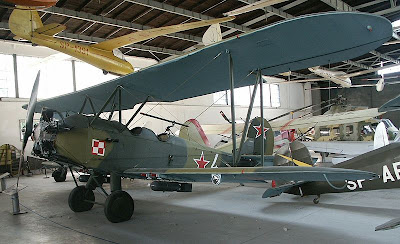 |
| Vought O2U-4 Corsair |
Introduction
The Vought O2U Corsair was a biplane scout and observation aircraft that entered service in the mid-1920’s. It was powered by a 400hp Pratt & Whitney R-1340 Wasp, and featured a steel-tube fuselage structure, with a wooden wing and a fabric cover. Many of them were seaplanes or amphibious aircraft.
The name Corsair was reused by Vought for their F4U fighter in 1938, and also for the LTV A-7 Corsair II attack bomber in 1963.
Development
In 1925, the US Navy issued specifications for a new observation aircraft. The Chance-Vought Corporation submitted plans, and two prototypes were ordered in 1926 to be tested by the Naval Trial Board before the first production batches were ordered. The aircraft, nicknamed Corsair, was the first service aircraft designed around the Pratt & Whitney Wasp engine – the first reliable air-cooled radial to match power with the water-cooled Liberty and Curtiss Hispano engines. In 1927, 291 O2U’s were produced. In 1928, minor changes resulted in the O2U-2, O2U-3, and O2U-4. By 1930, the O2U’s were superseded by O3U’s, which were basically the same as an O2U-4 but with a Grumman-made float. O3U’s were manufactured until 1936, with a total of 289 built. Many of them had an engine cowling, and some had enclosed cockpits.
When the 600-690hp Pratt & Whitney R-1690-42 Hornet was used, the designation was changed again to Su-1 through Su-4. The designation was changed to reflect the aircrafts main role as a scout. A total of 289 aircraft with the Su designation were built.
 |
| Corsair over Cavite, Philippines, 1930 |
Operational History
The Corsair was one of the most useful and versatile military aircraft ever produced. It was all that was desired by the Navy, and more. It set four world altitude and speed records, which gave it attention from foreign nations. In 1928, during the Nicaraguan campaign, Marine Corsairs were the first aircraft to ever conduct unsupported attacks against fortified positions, attacking 1500 rebels with light bombs and low-level strafing. Also during this campaign, Lt. Frank Schilt, USMC, won a Medal of Honor while flying a Corsair. It lasted in service for a long time - over 141 Corsairs were in service with the United States Navy and Marine Core when the United States entered World War II.
Many Corsairs were exported, with different designations. Argentina received V-65F’s, V-66F’s, and V-80Fp’s. V-80P’s went to Peru, V-85G’s went to Germany, Japan received the variants V-65C and V-92C, and Brazil received V-65B’s and V-65F’s, along with some hydroplanes designated V-66B’s.
In March of 1929, Mexico purchased twelve armed aircraft, designated O2U-2M and powered with 400hp Wasps, for the purpose of subduing a military coup. Mexico also built 31 aircraft under license and called them Corsairios Azcarate O2U-4A. In 1937, Mexico purchased ten V-99M’s with 550hp Pratt & Whitney R-1340-T1H-1 Wasps. Some may have been sent over to Spain.
China bought 42 export versions of the O2U-1 from 1929-33, and 21 export versions of the O3U between 1933-4. These aircraft were used extensively for bombing. The O2U-1’s flew during the Central Plains War and the January 28 Incident, while the O3U’s participated in the Battle of Pingxingguan, and over Shanghai.
In 1924, Peru purchased two Vought OSU’s, designated UO-1A. In 1929, they purchased twelve O2U-1’s for use as trainers. However, they did see action against APRA rebels and against Columbian ships and air assets during the Columbia-Peru War. None were lost to enemy fire, but several were lost to accidents.
Variants
O2U-1: 2 prototypes, 130 production aircraft. Interchangeable wheel/float landing gear. 28 aircraft for other customers. Powered with a 450hp Pratt & Whitney R-1340-88 Wasp.
O2U-2: 37 built; increased upper span, wing refinements, and larger rudder. Pratt & Whitney R-1340-B.
O2U-2M: O2U-2’s built for Mexico.
O2U-3: 110 built; revised wing rigging and redesigned tail surfaces. Pratt & Whitney R-1340-C.
O2U-3SD: O2U-3’s built for Santo Domingo.
O2U-4: 43 built (1 export, 7 civilian); similar to O2U-3 but with changed equipment.
O3U-1: 29 built; strengthened airframe. Pratt & Whitney R-1690 Hornet.
O3U-3: 76 built. Pratt & Whitney R-1340-12 Wasp.
O3U-4: 65 built. Pratt & Whitney R-1535.
XO3U-5: Test aircraft with a Pratt & Whitney R-1535
XO3U-6: Test aircraft – converted O3U-3 with NACA cowling and enclosed cockpits.
O3U-6: 32 built, 16 with Pratt & Whitney R-1340-12 Wasp, and 16 with Pratt & Whitney R-1340-18 Wasp.
SU-1: 28 built; scout version of the O3U-2.
SU-2: 53 built; scout version of the O3U-4.
SU-3: 20 built; SU-2 variant with low-pressure tires.
XSU-4: SU-2 converted as a prototype SU-4 with a 600hp R-1690-42 engine.
SU-4: 41 built; R-1690-2 engine.
V-65B: 36 built; export for Brazil.
V-65C: Export for Nationalist China.
V-65F: Export for Argentina.
V-66B: Export for Brazil.
V-66E: One aircraft evaluated by the RAF.
V-66F: Export for Brazil and Argentina.
V-80F: Export for Argentina.
V-80P: Export for Peru.
V-85G: Export for Germany.
V-92C: Export for Nationalist China.
V-93S: Export of the O3U-6 for Thailand.
V-99M: Export for Mexico.
TNCA Corsairo Axcarate: 31 built; O2U-4A’s built under license in Mexico.
AXV1: Single O2U supplied to the Imperial Japanese Navy for evaluation in 1929.
 |
| Corsair in the Royal Thai Air Force Museum |
Specifications
SU-4
Crew: 2
Length: 27ft 5.5in
Height: 11ft 4in
Wingspan: 36ft
Wing Area: 337 sq ft
Empty Weight: 3,312lb
Max Weight: 4,765lb
Powerplant: 1x 600hp Pratt & Whitney R-1690-42 Hornet radial engine
Max Speed: 167mpg @ sea level
Range: 680 miles
Ceiling: 18,600ft
Armament: 1x .30cal Browning machine gun, fixed forward; 2x .30cal Browning machine guns, flexible in rear cockpit
Sources:
http://www.aviastar.org/air/usa/vought_o2u.php
http://www.voughtaircraft.com/heritage/products/html/o2u.html
http://en.wikipedia.org/wiki/Vought_O2U_Corsair





















